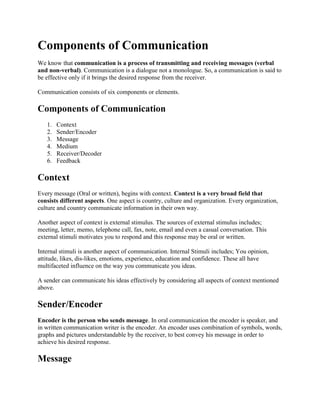
Bms3
- 1. Components of Communication We know that communication is a process of transmitting and receiving messages (verbal and non-verbal). Communication is a dialogue not a monologue. So, a communication is said to be effective only if it brings the desired response from the receiver. Communication consists of six components or elements. Components of Communication 1. Context 2. Sender/Encoder 3. Message 4. Medium 5. Receiver/Decoder 6. Feedback Context Every message (Oral or written), begins with context. Context is a very broad field that consists different aspects. One aspect is country, culture and organization. Every organization, culture and country communicate information in their own way. Another aspect of context is external stimulus. The sources of external stimulus includes; meeting, letter, memo, telephone call, fax, note, email and even a casual conversation. This external stimuli motivates you to respond and this response may be oral or written. Internal stimuli is another aspect of communication. Internal Stimuli includes; You opinion, attitude, likes, dis-likes, emotions, experience, education and confidence. These all have multifaceted influence on the way you communicate you ideas. A sender can communicate his ideas effectively by considering all aspects of context mentioned above. Sender/Encoder Encoder is the person who sends message. In oral communication the encoder is speaker, and in written communication writer is the encoder. An encoder uses combination of symbols, words, graphs and pictures understandable by the receiver, to best convey his message in order to achieve his desired response. Message
- 2. Message is the information that is exchanged between sender and receiver. The first task is to decide what you want to communicate and what would be the content of your message; what are the main points of your message and what other information to include. The central idea of the message must be clear. While writing the message, encoder should keep in mind all aspects of context and the receiver (How he will interpret the message). Messages can be intentional and unintentional. Medium Medium is the channel through which encoder will communicate his message. How the message gets there. Your medium to send a message, may be print, electronic, or sound. Medium may be a person as postman. The choice of medium totally depends on the nature of you message and contextual factors discussed above. Choice of medium is also influence by the relationship between the sender and receiver. The oral medium, to convey your message, is effective when your message is urgent, personal or when immediate feedback is desired. While, when your message is ling, technical and needs to be documented, then written medium should be preferred that is formal in nature. These guidelines may change while communicating internationally where complex situations are dealt orally and communicated in writing later on. Receiver/Decoder The person to whom the message is being sent is called ‘receiver’/'decoder’. Receiver may be a listener or a reader depending on the choice of medium by sender to transmit the message. Receiver is also influenced by the context, internal and external stimuli. Receiver is the person who interprets the message, so higher the chances are of mis- communication because of receivers perception, opinion, attitude and personality. There will be minor deviation in transmitting the exact idea only if your receiver is educated and have communication skills. Feedback Response or reaction of the receiver, to a message, is called ‘feedback’. Feedback may be written or oral message, an action or simply, silence may also be a feedback to a message. Feedback is the most important component of communication in business. Communication is said to be effective only when it receives some feedback. Feedback, actually, completes the loop of communication.